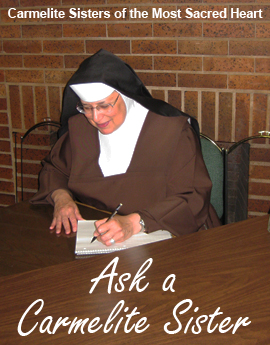Carmelite Sisters | May 23, 2012

Ask a Carmelite Sister
Dear Sister,
I understand what it means to pray using vocal prayers, that is, praying aloud either alone or with others. I also understand, I think, about meditation. Meditation is thinking about, reflecting upon, and applying some biblical or other spiritual thought to my own life. But… contemplation? I don’t have a clue. I guess it’s just not for me. I’m a very practical person and have never (yet) been able to grasp this idea of contemplative prayer. Do you have anything that could help me understand?
Dear Friend,
Thank you for your question. It seems to me that most people who are trying to lead a good life sooner or later come to this question. Some people think that maybe they aren’t praying often enough or hard enough or long enough. Others mistakenly try to acquire contemplation through various methods that are “out there.” What all of them need to realize is that prayer is a relationship and it very beautifully grows just like any other relationship.
Prayer, in the general sense, is nothing more than your personal relationship with God. So, let’s talk about relationships. You could choose to talk to someone out loud. That’s vocal prayer. You or you could quietly think about the person. That’s meditation. Or, as in the case of let’s say a couple that’s been married for many, many years, the two of you could just quietly sit together without saying anything at all. That’s contemplation.
Another example would be a beach example. You could stand on the beach and voice aloud a poem which tells how much you love being at the beach. Again, that’s vocal prayer. Or you could engage in the activity of trying to identify different kinds of shells by referring to a book, and then deciding where you might find these shells on this particular beach. That would be like Meditation. Or at sunset you can just sit quietly on the beach and drink in the beauty of the sunset. That would be Contemplation.
A new baby in the home provides another example. The mom can talk to the baby or sing. That’s like vocal prayer. Or, she could read about parenting and apply what she is reading to her own baby. That’s like meditation. Or she could hold her newborn baby in her arms and just look with love at that beautiful infant. That is contemplation.

St. John of the Cross
St. John of the Cross teaches that in the normal progression of the prayer journey, one starts with vocal prayers, then moves into meditation, and ultimately reaches contemplative prayer – although this is not a hard and fast rule.
He gives three criteria to help one see if he or she is at the transition into contemplative prayer. Here they are:
Three Signs of Transition into Contemplative Prayer
“The first [sign] is that as these souls do not get satisfaction or consolation from the things of God, they do not get any from creatures either.”
The soul experiences a lack of satisfaction either in God’s things or in creatures. Material or sensual pleasures no longer satisfy you, but at the same time there is nothing else, material or spiritual that satisfies you, either.
“The second sign . . . is that the memory ordinarily turns to God solicitously and with painful care, and the soul thinks it is not serving God but turning back, because it is aware of this distaste for the things of God.”
The soul feels as though it is not serving God, and may even have distaste for spiritual things. Whereas before, it was easy or comforting to pray, it no longer is. In fact, you may not even want to pray anymore. The soul wonders if it is taking a step backward, rather than forward, wondering if it has done something wrong and is being punished.
“The third sign . . . is that the powerlessness, in spite of one’s efforts, to meditate and make use of the imagination . . . as was one’s previous custom.”
It is impossible to meditate. The previous way of prayer doesn’t work at all anymore and there doesn’t seem to be a new way of prayer emerging yet.
Basically, that’s it. Father Thomas Dubay, during retreats he has given to our community of sisters, would say the following, “If you experience a dry longing for God, and can’t seem to pray anymore like you used to, you are transitioning into contemplative prayer.”
And, I’d like to also pass on to you what a Carmelite priest once told us. He said that if firewood is wet, or still damp, when you try to start a fire, it won’t ignite. We allow the wood to dry out first. Then we burn it in the fireplace. In the same way, prior to contemplative prayer, the soul is allowed a time to “dry out”… thus, the “dry longing for God” until that moment when our God Who is a consuming fire, burns His love into our very souls through contemplation.
I hope one or more of the ideas here help you. The concept that is taken for granted in all of this is the premise that you are in the state of grace and really trying to lead a good life. That comes first.
I hope that is of help to you and until next time,
Sister Laus Gloriae, O.C.D.
Send your questions for Sister to asksister@integratedcatholiclife.org.
Dear Sister,
I understand what it means to pray using vocal prayers, that is, praying aloud either alone or with others. I also understand, I think, about meditation. Meditation is thinking about, reflecting upon, and applying some biblical or other spiritual thought to my own life. But… contemplation? I don’t have a clue. I guess it’s just not for me. I’m a very practical person and have never (yet) been able to grasp this idea of contemplative prayer. Do you have anything that could help me understand?
Dear Friend,
Thank you for your question. It seems to me that most people who are trying to lead a good life sooner or later come to this question. Some people think that maybe they aren’t praying often enough or hard enough or long enough. Others mistakenly try to acquire contemplation through various methods that are “out there.” What all of them need to realize is that prayer is a relationship and it very beautifully grows just like any other relationship.
Prayer, in the general sense, is nothing more than your personal relationship with God. So, let’s talk about relationships. You could choose to talk to someone out loud. That’s vocal prayer. You or you could quietly think about the person. That’s meditation. Or, as in the case of let’s say a couple that’s been married for many, many years, the two of you could just quietly sit together without saying anything at all. That’s contemplation.
Another example would be a beach example. You could stand on the beach and voice aloud a poem which tells how much you love being at the beach. Again, that’s vocal prayer. Or you could engage in the activity of trying to identify different kinds of shells by referring to a book, and then deciding where you might find these shells on this particular beach. That would be like Meditation. Or at sunset you can just sit quietly on the beach and drink in the beauty of the sunset. That would be Contemplation.
A new baby in the home provides another example. The mom can talk to the baby or sing. That’s like vocal prayer. Or, she could read about parenting and apply what she is reading to her own baby. That’s like meditation. Or she could hold her newborn baby in her arms and just look with love at that beautiful infant. That is contemplation.

St. John of the Cross
St. John of the Cross teaches that in the normal progression of the prayer journey, one starts with vocal prayers, then moves into meditation, and ultimately reaches contemplative prayer – although this is not a hard and fast rule.
He gives three criteria to help one see if he or she is at the transition into contemplative prayer. Here they are:
Three Signs of Transition into Contemplative Prayer
“The first [sign] is that as these souls do not get satisfaction or consolation from the things of God, they do not get any from creatures either.”
The soul experiences a lack of satisfaction either in God’s things or in creatures. Material or sensual pleasures no longer satisfy you, but at the same time there is nothing else, material or spiritual that satisfies you, either.
“The second sign . . . is that the memory ordinarily turns to God solicitously and with painful care, and the soul thinks it is not serving God but turning back, because it is aware of this distaste for the things of God.”
The soul feels as though it is not serving God, and may even have distaste for spiritual things. Whereas before, it was easy or comforting to pray, it no longer is. In fact, you may not even want to pray anymore. The soul wonders if it is taking a step backward, rather than forward, wondering if it has done something wrong and is being punished.
“The third sign . . . is that the powerlessness, in spite of one’s efforts, to meditate and make use of the imagination . . . as was one’s previous custom.”
It is impossible to meditate. The previous way of prayer doesn’t work at all anymore and there doesn’t seem to be a new way of prayer emerging yet.
Basically, that’s it. Father Thomas Dubay, during retreats he has given to our community of sisters, would say the following, “If you experience a dry longing for God, and can’t seem to pray anymore like you used to, you are transitioning into contemplative prayer.”
And, I’d like to also pass on to you what a Carmelite priest once told us. He said that if firewood is wet, or still damp, when you try to start a fire, it won’t ignite. We allow the wood to dry out first. Then we burn it in the fireplace. In the same way, prior to contemplative prayer, the soul is allowed a time to “dry out”… thus, the “dry longing for God” until that moment when our God Who is a consuming fire, burns His love into our very souls through contemplation.
I hope one or more of the ideas here help you. The concept that is taken for granted in all of this is the premise that you are in the state of grace and really trying to lead a good life. That comes first.
I hope that is of help to you and until next time,
Sister Laus Gloriae, O.C.D.
Send your questions for Sister to asksister@integratedcatholiclife.org.
No comments:
Post a Comment